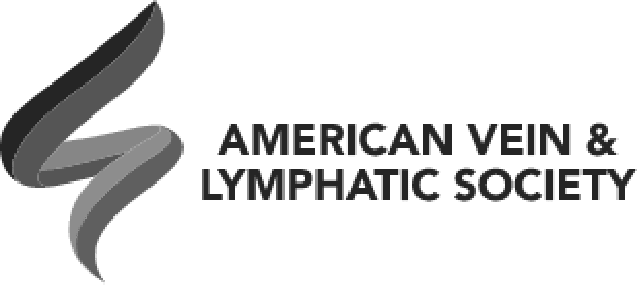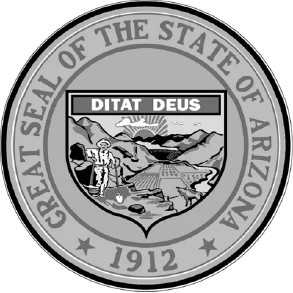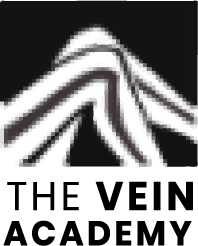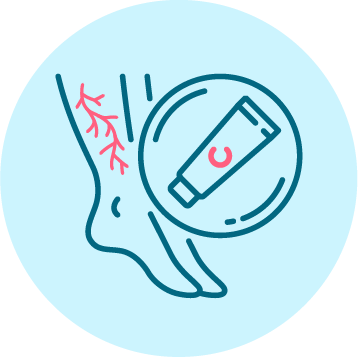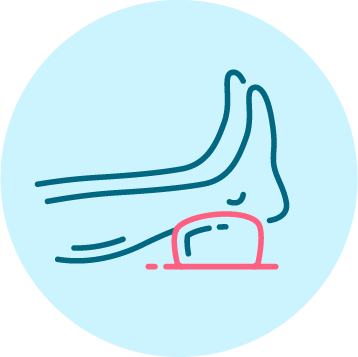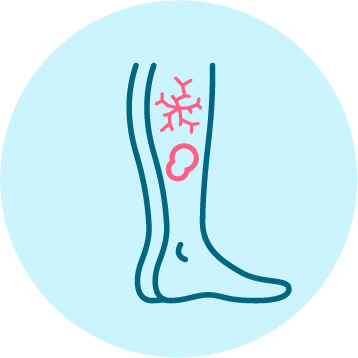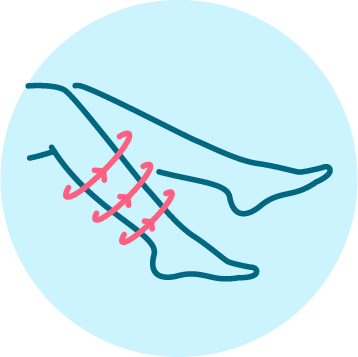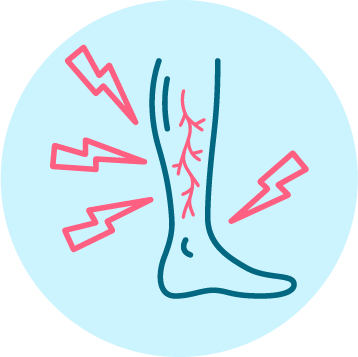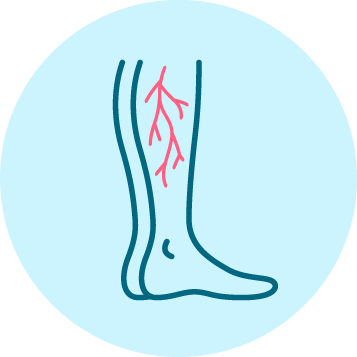Leg Pain / Aching / Cramping
Leg pain, aching, and cramping are often signs of underlying vein disease, a condition that affects blood flow in the legs. Poor circulation, varicose veins, and blood clots can disrupt the normal movement of blood back to the heart, leading to discomfort and potential complications if left untreated. These symptoms may worsen with prolonged standing or sitting and often improve with elevation of the legs.
- Varicose Veins: Enlarged, twisted veins caused by faulty valves.
- Chronic Venous Insufficiency (CVI): Inadequate blood flow due to weakened or damaged vein walls and valves.
- Deep Vein Thrombosis (DVT): Blood clots in deep veins that can lead to serious complications.
- Spider Veins: Smaller, superficial veins that may contribute to discomfort.
A thorough evaluation is critical to understanding the root cause of your symptoms. Our diagnostic process includes:
- Initial Consultation
Discussing your medical history and symptoms in detail. - Physical Assessment
Identifying visible signs like varicose or spider veins. - Ultrasound Imaging
Non-invasive ultrasound to assess blood flow and locate problem areas. - Personalized Treatment Plan
Tailored recommendations based on your specific diagnosis.
We use cutting-edge, minimally invasive procedures to address vein-related issues effectively, helping you achieve symptom relief and improved circulation:
- Radiofrequency Ablation (ClosureFast)
Heat-based treatment that seals damaged veins. - Compounded Sclerotherapy
Injection of a medicated solution to collapse smaller, problematic veins. - Varithena Ablation
Foam-based injection to target larger varicose veins.
Common Causes
- Varicose Veins: Enlarged, twisted veins caused by faulty valves.
- Chronic Venous Insufficiency (CVI): Inadequate blood flow due to weakened or damaged vein walls and valves.
- Deep Vein Thrombosis (DVT): Blood clots in deep veins that can lead to serious complications.
- Spider Veins: Smaller, superficial veins that may contribute to discomfort.
How We Diagnose
A thorough evaluation is critical to understanding the root cause of your symptoms. Our diagnostic process includes:
- Initial Consultation
Discussing your medical history and symptoms in detail. - Physical Assessment
Identifying visible signs like varicose or spider veins. - Ultrasound Imaging
Non-invasive ultrasound to assess blood flow and locate problem areas. - Personalized Treatment Plan
Tailored recommendations based on your specific diagnosis.
Advanced Treatment Options
We use cutting-edge, minimally invasive procedures to address vein-related issues effectively, helping you achieve symptom relief and improved circulation.
- Radiofrequency Ablation (ClosureFast)
Heat-based treatment that seals damaged veins. - Compounded Sclerotherapy
Injection of a medicated solution to collapse smaller, problematic veins. - Varithena Ablation
Foam-based injection to target larger varicose veins.
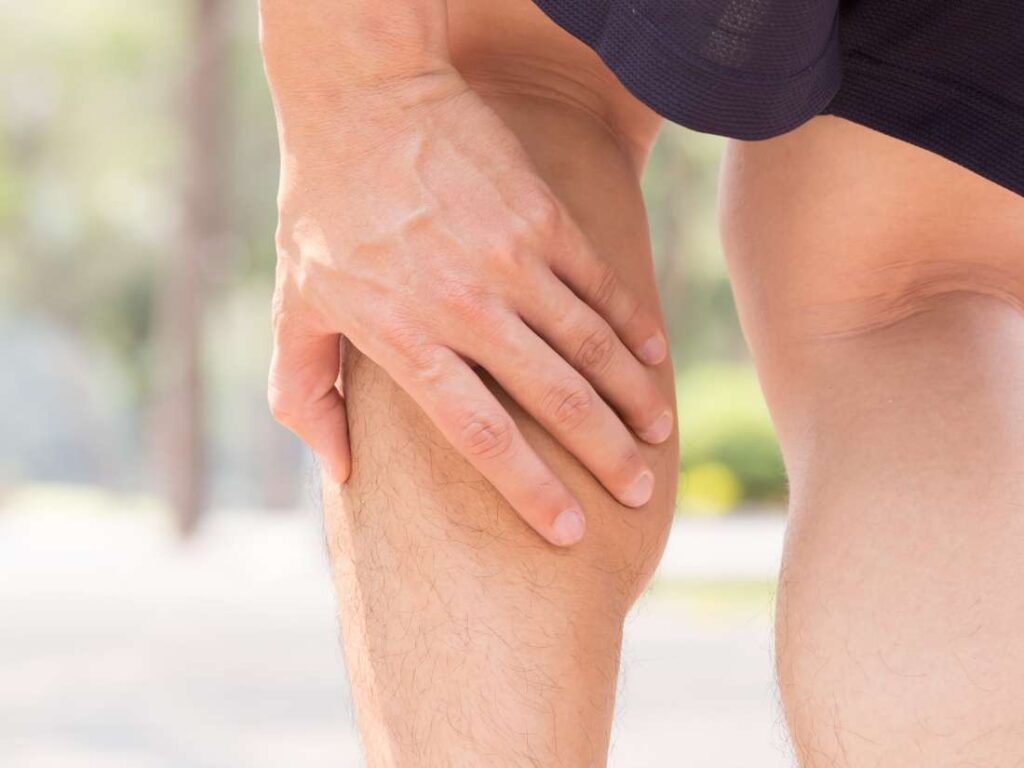
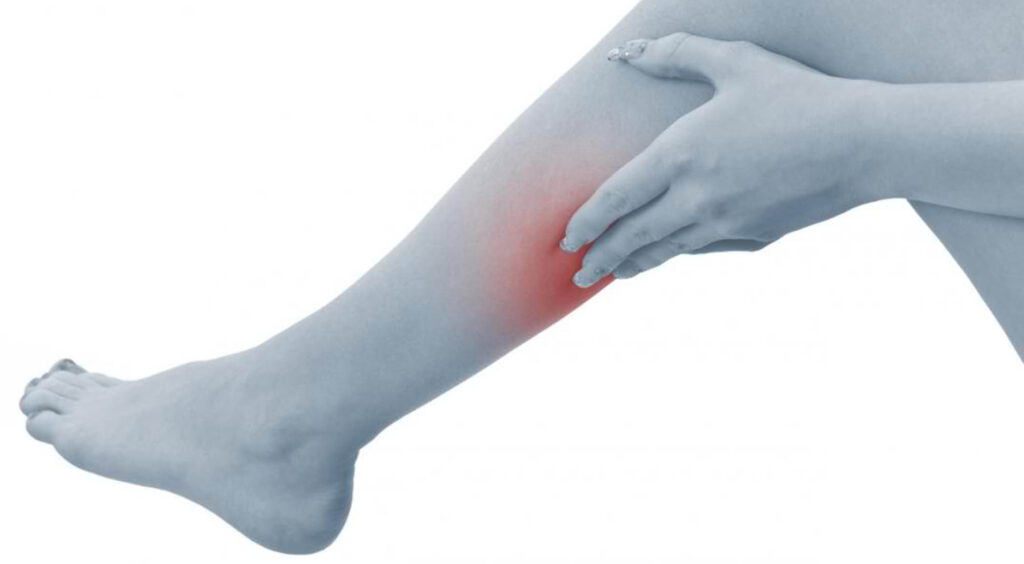
Skin Changes / Discoloration
- Hyperpigmentation: Darkening of the skin, often appearing brown or reddish, typically around the ankles or lower legs.
- Lipodermatosclerosis: Hardened or thickened skin due to chronic inflammation and scarring.
- Venous Stasis Dermatitis: Itchy, red, or scaly skin caused by prolonged venous insufficiency.
- Ulcer Formation: Open sores that develop when skin and underlying tissues break down due to chronic venous pressure.
- Atrophie Blanche: White, scar-like patches of skin with small, visible veins around the area.
A comprehensive diagnostic process helps us determine the root cause of your skin changes and discoloration:
- Initial Consultation
Discussing your symptoms, medical history, and lifestyle factors. - Physical Examination
Identifying visible signs of venous disease, such as discoloration, texture changes, or ulcers. - Ultrasound Imaging
Non-invasive ultrasound to assess blood flow and pinpoint vein abnormalities. - Personalized Treatment Plan
Developing a tailored approach to restore healthy circulation and improve skin health.
Our minimally invasive procedures address the underlying causes of skin changes while promoting healing and restoring a more natural appearance:
- Radiofrequency Ablation (ClosureFast)
Heat-based treatment that seals damaged veins. - Compounded Sclerotherapy
Injection of a medicated solution to collapse smaller, problematic veins. - Varithena Ablation
Foam-based injection to target larger varicose veins.
Common Causes
- Hyperpigmentation: Darkening of the skin, often appearing brown or reddish, typically around the ankles or lower legs.
- Lipodermatosclerosis: Hardened or thickened skin due to chronic inflammation and scarring.
- Venous Stasis Dermatitis: Itchy, red, or scaly skin caused by prolonged venous insufficiency.
- Ulcer Formation: Open sores that develop when skin and underlying tissues break down due to chronic venous pressure.
- Atrophie Blanche: White, scar-like patches of skin with small, visible veins around the area.
How We Diagnose
A comprehensive diagnostic process helps us determine the root cause of your skin changes and discoloration:
- Initial Consultation
Discussing your symptoms, medical history, and lifestyle factors. - Physical Examination
Identifying visible signs of venous disease, such as discoloration, texture changes, or ulcers. - Ultrasound Imaging
Non-invasive ultrasound to assess blood flow and pinpoint vein abnormalities. - Personalized Treatment Plan
Developing a tailored approach to restore healthy circulation and improve skin health.
Advanced Treatment Options
Our minimally invasive procedures address the underlying causes of skin changes while promoting healing and restoring a more natural appearance:
- Radiofrequency Ablation (ClosureFast)
Heat-based treatment that seals damaged veins. - Compounded Sclerotherapy
Injection of a medicated solution to collapse smaller, problematic veins. - Varithena Ablation
Foam-based injection to target larger varicose veins.
Leg or Ankle Swelling
Leg and ankle swelling, also known as edema, occurs when fluid builds up in the tissues of the lower extremities. This swelling can range from mild to severe and is often a symptom of underlying vein or lymphatic system damage. Left untreated, chronic swelling can lead to discomfort, skin changes, and an increased risk of infection or ulcers.
- Venous Insufficiency: When vein valves don’t function properly, blood pools in the lower legs, causing swelling.
- Lymphedema: Damage to the lymphatic system leads to fluid accumulation.
- Varicose Veins: Enlarged, twisted veins disrupt normal blood flow, contributing to fluid retention.
- Prolonged Standing or Sitting: These activities can worsen swelling by restricting proper circulation.
- Deep Vein Thrombosis (DVT): A blood clot in a deep vein can obstruct blood flow, resulting in swelling.
A comprehensive evaluation helps us identify the root cause of your swelling and create an effective treatment plan.
- Initial Consultation
Discussion of symptoms, medical history, and lifestyle factors. - Physical Assessment
Examination of the legs for signs of swelling, discoloration, or vein issues. - Ultrasound Imaging
Non-invasive ultrasound to evaluate blood flow and identify vein abnormalities. - Customized Treatment Plan
A tailored approach based on your specific diagnosis and needs.
Our cutting-edge treatments target the underlying causes of swelling, providing relief and promoting long-term leg health:
- Radiofrequency Ablation (ClosureFast)
Heat-based treatment that seals damaged veins. - Compounded Sclerotherapy
Injection of a medicated solution to collapse smaller, problematic veins. - Varithena Ablation
Foam-based injection to target larger varicose veins.
Common Causes
- Venous Insufficiency: When vein valves don’t function properly, blood pools in the lower legs, causing swelling.
- Lymphedema: Damage to the lymphatic system leads to fluid accumulation.
- Varicose Veins: Enlarged, twisted veins disrupt normal blood flow, contributing to fluid retention.
- Prolonged Standing or Sitting: These activities can worsen swelling by restricting proper circulation.
- Deep Vein Thrombosis (DVT): A blood clot in a deep vein can obstruct blood flow, resulting in swelling.
How We Diagnose
A comprehensive evaluation helps us identify the root cause of your swelling and create an effective treatment plan.
- Initial Consultation
Discussion of symptoms, medical history, and lifestyle factors. - Physical Assessment
Examination of the legs for signs of swelling, discoloration, or vein issues. - Ultrasound Imaging
Non-invasive ultrasound to evaluate blood flow and identify vein abnormalities. - Customized Treatment Plan
A tailored approach based on your specific diagnosis and needs.
Advanced Treatment Options
Our cutting-edge treatments target the underlying causes of swelling, providing relief and promoting long-term leg health:
- Radiofrequency Ablation (ClosureFast)
Heat-based treatment that seals damaged veins. - Compounded Sclerotherapy
Injection of a medicated solution to collapse smaller, problematic veins. - Varithena Ablation
Foam-based injection to target larger varicose veins.

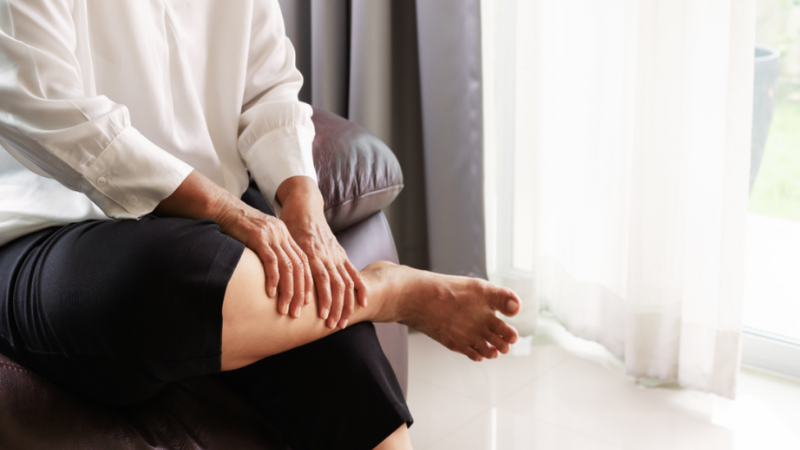
Leg Heaviness & Fatigue
- Venous Insufficiency: Weakened vein valves disrupt blood flow, causing pooling and heaviness.
- Varicose Veins: Enlarged veins create increased pressure and fatigue in the legs.
- Poor Circulation: Reduced blood flow leads to insufficient oxygen and nutrients in the leg muscles.
- Prolonged Activity or Inactivity: Standing or sitting for extended periods exacerbates these symptoms.
Our thorough diagnostic process ensures we identify the root cause of your symptoms and recommend the best course of action:
- Initial Consultation
Discussion of your symptoms, medical history, and lifestyle factors. - Physical Assessment
Examination for visible signs of vein disease, such as varicose veins or swelling. - Ultrasound Imaging
Non-invasive ultrasound to assess blood flow and locate problematic veins. - Personalized Treatment Plan
A tailored approach to address your specific condition and goals.
- Radiofrequency Ablation (ClosureFast) Heat-based treatment that seals damaged veins.
- Compounded Sclerotherapy Injection of a medicated solution to collapse smaller, problematic veins.
- Varithena Ablation Foam-based injection to target larger varicose veins.
Common Causes
- Venous Insufficiency: Weakened vein valves disrupt blood flow, causing pooling and heaviness.
- Varicose Veins: Enlarged veins create increased pressure and fatigue in the legs.
- Poor Circulation: Reduced blood flow leads to insufficient oxygen and nutrients in the leg muscles.
- Prolonged Activity or Inactivity: Standing or sitting for extended periods exacerbates these symptoms.
How We Diagnose
Our thorough diagnostic process ensures we identify the root cause of your symptoms and recommend the best course of action:
- Initial Consultation
Discussion of your symptoms, medical history, and lifestyle factors. - Physical Assessment
Examination for visible signs of vein disease, such as varicose veins or swelling. - Ultrasound Imaging
Non-invasive ultrasound to assess blood flow and locate problematic veins. - Personalized Treatment Plan
A tailored approach to address your specific condition and goals.
Advanced Treatment Options
We offer state-of-the-art, minimally invasive procedures designed to improve circulation, alleviate symptoms, and enhance your quality of life:
- Radiofrequency Ablation (ClosureFast)
Heat-based treatment that seals damaged veins. - Compounded Sclerotherapy
Injection of a medicated solution to collapse smaller, problematic veins. - Varithena Ablation
Foam-based injection to target larger varicose veins.
Ulcers / Sores / Open Wounds
- Chronic Venous Insufficiency (CVI): Faulty vein valves result in poor blood flow, increasing pressure and skin damage.
- Varicose Veins: Enlarged veins disrupt circulation, contributing to tissue breakdown over time.
- Venous Hypertension: Increased pressure in the veins causes inflammation and impaired healing.
- Previous Injuries or Surgeries: Trauma can exacerbate venous issues, delaying wound healing.
Our diagnostic approach focuses on identifying the underlying cause of the wound to ensure effective treatment and faster healing:
- Initial Consultation
Discussing your symptoms, medical history, and wound progression. - Physical Examination
Inspecting the wound and surrounding area for signs of infection, swelling, or discoloration. - Ultrasound Imaging
Using ultrasound to assess blood flow, locate venous obstructions, and evaluate vein function. - Customized Treatment Plan
Developing a tailored strategy to promote wound healing and address the root cause.
We offer state-of-the-art, minimally invasive treatments that address the underlying vein disease while promoting faster healing of ulcers and sores:
- Radiofrequency Ablation (ClosureFast)
Heat-based treatment that seals damaged veins. - Compounded Sclerotherapy
Injection of a medicated solution to collapse smaller, problematic veins. - Varithena Ablation
Foam-based injection to target larger varicose veins.
Common Causes
- Chronic Venous Insufficiency (CVI): Faulty vein valves result in poor blood flow, increasing pressure and skin damage.
- Varicose Veins: Enlarged veins disrupt circulation, contributing to tissue breakdown over time.
- Venous Hypertension: Increased pressure in the veins causes inflammation and impaired healing.
- Previous Injuries or Surgeries: Trauma can exacerbate venous issues, delaying wound healing.
How We Diagnose
Our diagnostic approach focuses on identifying the underlying cause of the wound to ensure effective treatment and faster healing:
- Initial Consultation
Discussing your symptoms, medical history, and wound progression. - Physical Examination
Inspecting the wound and surrounding area for signs of infection, swelling, or discoloration. - Ultrasound Imaging
Using ultrasound to assess blood flow, locate venous obstructions, and evaluate vein function. - Customized Treatment Plan
Developing a tailored strategy to promote wound healing and address the root cause.
Advanced Treatment Options
We offer state-of-the-art, minimally invasive treatments that address the underlying vein disease while promoting faster healing of ulcers and sores:
- Radiofrequency Ablation (ClosureFast)
Heat-based treatment that seals damaged veins. - Compounded Sclerotherapy
Injection of a medicated solution to collapse smaller, problematic veins. - Varithena Ablation
Foam-based injection to target larger varicose veins.
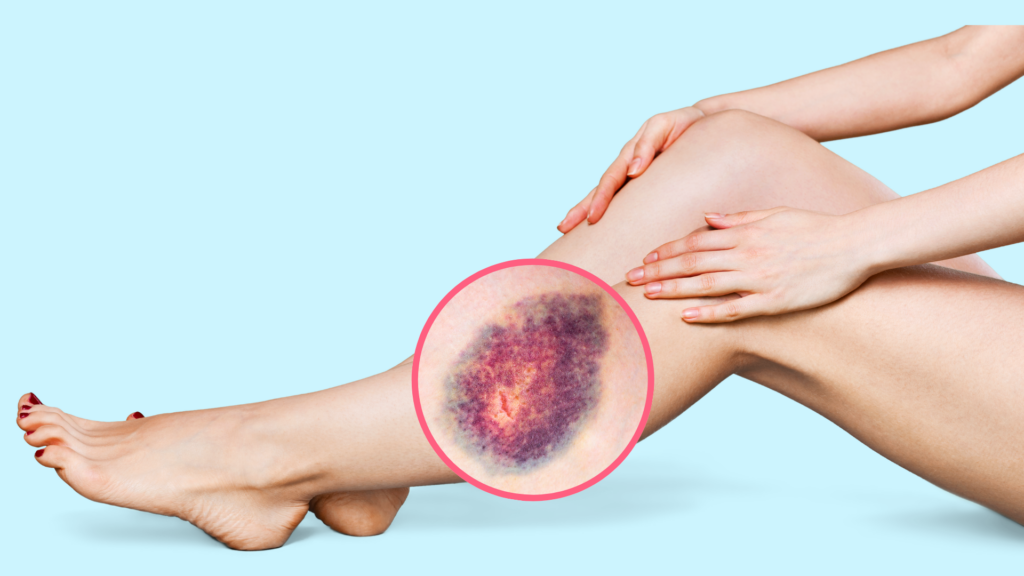
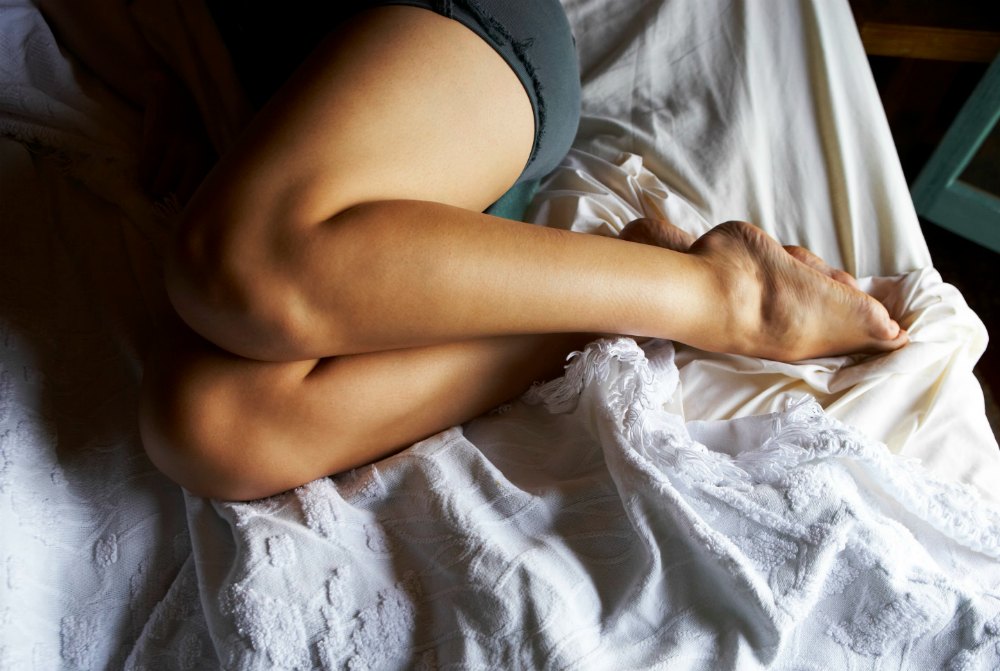
Restlessness in the Legs
- Chronic Venous Insufficiency (CVI): Faulty vein valves cause poor circulation, leading to increased pressure and leg discomfort.
- Varicose Veins: Enlarged veins disrupt blood flow, contributing to the sensations of heaviness and restlessness in the legs.
- Venous Hypertension: High pressure in the veins can trigger symptoms of restless legs, especially during periods of inactivity or rest.
- Nerve Compression or Damage: Poor circulation can aggravate nerve function, leading to restless leg symptoms.
Our diagnostic approach focuses on identifying the underlying circulatory issues contributing to restless legs, allowing us to recommend the most effective treatment plan:
- Initial Consultation
Discussing your symptoms, medical history, and leg discomfort patterns. - Physical Examination
Evaluating the legs for visible signs of vein disease, such as varicose veins or skin changes. - Ultrasound Imaging
Assessing blood flow in the veins, identifying obstructions, and evaluating vein function. - Customized Treatment Plan
Creating a personalized strategy to address both the symptoms and the root cause of restless legs.
We offer cutting-edge, minimally invasive treatments designed to improve circulation, reduce discomfort, and eliminate the root cause of restless legs:
- Radiofrequency Ablation (ClosureFast)
Heat-based treatment that seals damaged veins. - Compounded Sclerotherapy
Injection of a medicated solution to collapse smaller, problematic veins. - Varithena Ablation
Foam-based injection to target larger varicose veins.
Common Causes
- Chronic Venous Insufficiency (CVI): Faulty vein valves cause poor circulation, leading to increased pressure and leg discomfort.
- Varicose Veins: Enlarged veins disrupt blood flow, contributing to the sensations of heaviness and restlessness in the legs.
- Venous Hypertension: High pressure in the veins can trigger symptoms of restless legs, especially during periods of inactivity or rest.
- Nerve Compression or Damage: Poor circulation can aggravate nerve function, leading to restless leg symptoms.
How We Diagnose
Our diagnostic approach focuses on identifying the underlying circulatory issues contributing to restless legs, allowing us to recommend the most effective treatment plan:
- Initial Consultation
Discussing your symptoms, medical history, and leg discomfort patterns. - Physical Examination
Evaluating the legs for visible signs of vein disease, such as varicose veins or skin changes. - Ultrasound Imaging
Assessing blood flow in the veins, identifying obstructions, and evaluating vein function. - Customized Treatment Plan
Creating a personalized strategy to address both the symptoms and the root cause of restless legs.
Advanced Treatment Options
We offer cutting-edge, minimally invasive treatments designed to improve circulation, reduce discomfort, and eliminate the root cause of restless legs:
- Radiofrequency Ablation (ClosureFast)
Heat-based treatment that seals damaged veins. - Compounded Sclerotherapy
Injection of a medicated solution to collapse smaller, problematic veins. - Varithena Ablation
Foam-based injection to target larger varicose veins.
Tingling or Burning in Leg
- Chronic Venous Insufficiency (CVI): Damaged vein valves hinder proper blood flow, leading to discomfort and skin irritation.
- Varicose Veins: Enlarged veins disrupt circulation, contributing to sensations of burning or tingling in the legs.
- Venous Hypertension: Increased pressure in the veins causes irritation in the skin and nerves, leading to burning sensations.
- Nerve Impairment: Reduced blood flow to the nerves can cause tingling or a “pins-and-needles” feeling.
To effectively address tingling or burning in the leg, we focus on determining the underlying venous issue causing the discomfort:
- Initial Consultation
Discussing your symptoms, medical history, and leg discomfort patterns. - Physical Examination
Inspecting the legs for signs of varicose veins, swelling, or skin changes. - Ultrasound Imaging
Using ultrasound to assess blood flow and identify any blockages or vein dysfunction. - Customized Treatment Plan
Developing a tailored treatment plan to improve circulation and alleviate symptoms.
Our minimally invasive treatments are designed to address the underlying vein issues, restore healthy blood flow, and relieve tingling or burning sensations in the legs:
- Radiofrequency Ablation (ClosureFast)
Heat-based treatment that seals damaged veins. - Compounded Sclerotherapy
Injection of a medicated solution to collapse smaller, problematic veins. - Varithena Ablation
Foam-based injection to target larger varicose veins.
Common Causes
- Chronic Venous Insufficiency (CVI): Damaged vein valves hinder proper blood flow, leading to discomfort and skin irritation.
- Varicose Veins: Enlarged veins disrupt circulation, contributing to sensations of burning or tingling in the legs.
- Venous Hypertension: Increased pressure in the veins causes irritation in the skin and nerves, leading to burning sensations.
- Nerve Impairment: Reduced blood flow to the nerves can cause tingling or a “pins-and-needles” feeling.
How We Diagnose
To effectively address tingling or burning in the leg, we focus on determining the underlying venous issue causing the discomfort:
- Initial Consultation
Discussing your symptoms, medical history, and leg discomfort patterns. - Physical Examination
Inspecting the legs for signs of varicose veins, swelling, or skin changes. - Ultrasound Imaging
Using ultrasound to assess blood flow and identify any blockages or vein dysfunction. - Customized Treatment Plan
Developing a tailored treatment plan to improve circulation and alleviate symptoms.
Advanced Treatment Options
Our minimally invasive treatments are designed to address the underlying vein issues, restore healthy blood flow, and relieve tingling or burning sensations in the legs:
- Radiofrequency Ablation (ClosureFast)
Heat-based treatment that seals damaged veins. - Compounded Sclerotherapy
Injection of a medicated solution to collapse smaller, problematic veins. - Varithena Ablation
Foam-based injection to target larger varicose veins.
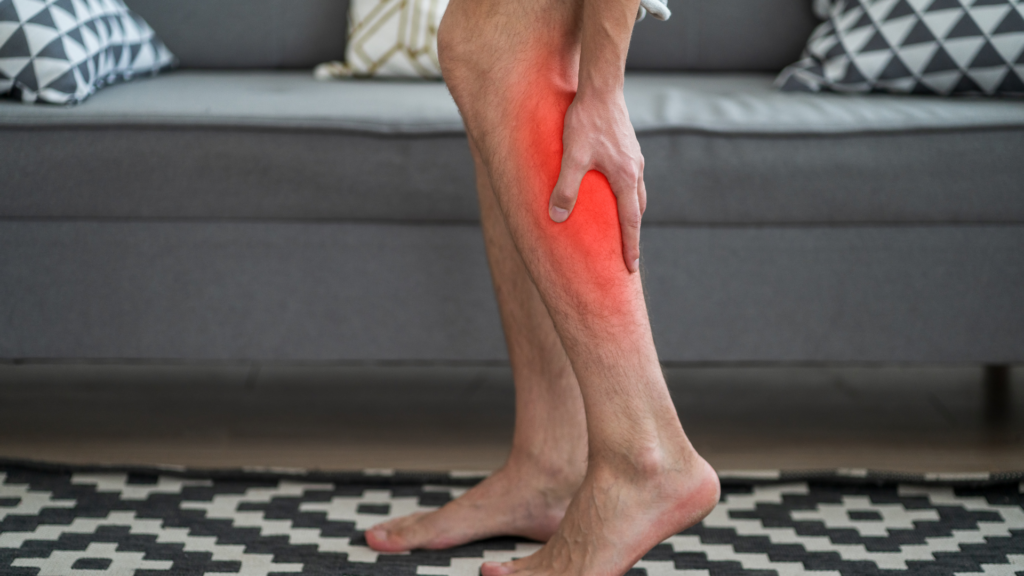
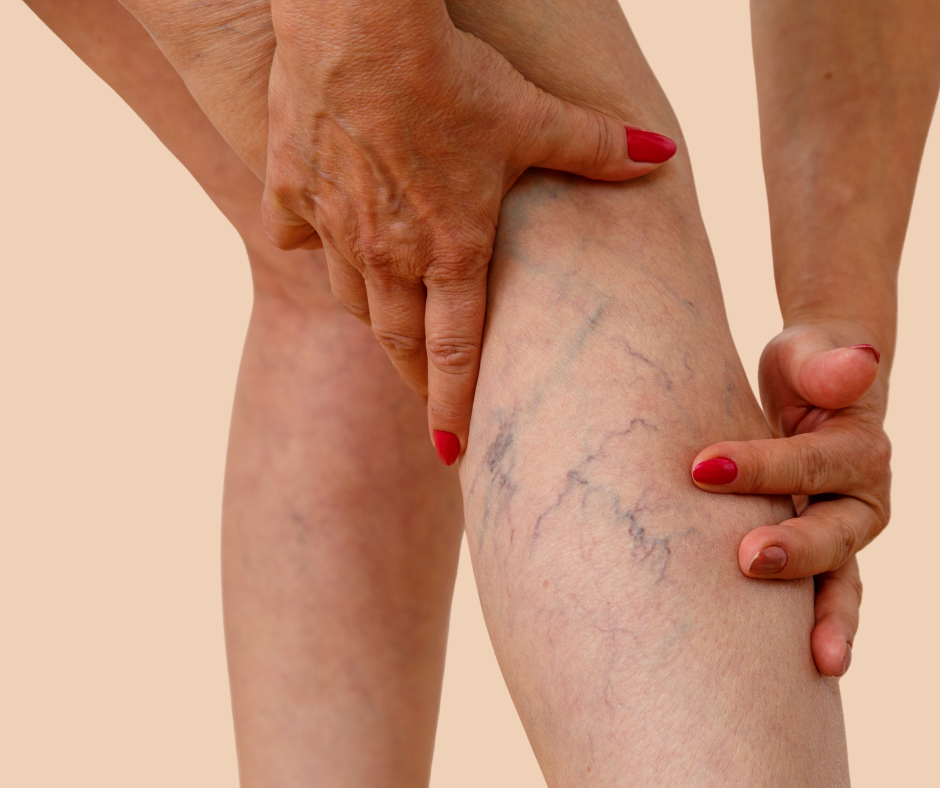
Varicose and Spider Veins
- Chronic Venous Insufficiency (CVI): Faulty vein valves allow blood to flow backward, increasing pressure and causing veins to become enlarged.
- Varicose Veins: High blood pressure in leg veins leads to the swelling and twisting of veins.
- Genetics: A family history of vein disease increases the risk of developing varicose and spider veins.
- Hormonal Changes: Pregnancy, menopause, or hormone therapy can weaken vein walls and lead to vein enlargement.
- Prolonged Standing or Sitting: Long periods of inactivity can cause blood to pool in the veins, increasing pressure and contributing to vein enlargement.
- Initial Consultation Discussing your symptoms, family history, and vein concerns.
- Physical Examination Inspecting the veins for signs of swelling, bulging, or discoloration.
- Ultrasound Imaging Assessing the veins to identify any reflux (backward blood flow) and evaluate vein health.
- Customized Treatment Plan Creating a personalized plan to address both the visible veins and the underlying circulation issues.
We offer minimally invasive treatments to eliminate varicose and spider veins while improving circulation:
- Radiofrequency Ablation (ClosureFast)
Heat-based treatment that seals damaged veins. - Compounded Sclerotherapy
Injection of a medicated solution to collapse smaller, problematic veins. - Varithena Ablation
Foam-based injection to target larger varicose veins.
Common Causes
- Chronic Venous Insufficiency (CVI): Faulty vein valves allow blood to flow backward, increasing pressure and causing veins to become enlarged.
- Varicose Veins: High blood pressure in leg veins leads to the swelling and twisting of veins.
- Genetics: A family history of vein disease increases the risk of developing varicose and spider veins.
- Hormonal Changes: Pregnancy, menopause, or hormone therapy can weaken vein walls and lead to vein enlargement.
- Prolonged Standing or Sitting: Long periods of inactivity can cause blood to pool in the veins, increasing pressure and contributing to vein enlargement.
How We Diagnose
Our diagnostic process focuses on identifying the underlying causes of varicose and spider veins, allowing for the most effective treatment:
- Initial Consultation
Discussing your symptoms, family history, and vein concerns. - Physical Examination
Inspecting the veins for signs of swelling, bulging, or discoloration. - Ultrasound Imaging
Assessing the veins to identify any reflux (backward blood flow) and evaluate vein health. - Customized Treatment Plan
Creating a personalized plan to address both the visible veins and the underlying circulation issues.
Advanced Treatment Options
We offer minimally invasive treatments to eliminate varicose and spider veins while improving circulation:
- Radiofrequency Ablation (ClosureFast)
Heat-based treatment that seals damaged veins. - Compounded Sclerotherapy
Injection of a medicated solution to collapse smaller, problematic veins. - Varithena Ablation
Foam-based injection to target larger varicose veins.
Why Start Vein Treatment Now?
- Untreated vein disease can lead to serious complications like ulcers or blood clots.
- Early treatment not only alleviates discomfort but also prevents further issues.
- Most patients notice a significant improvement within a week!
